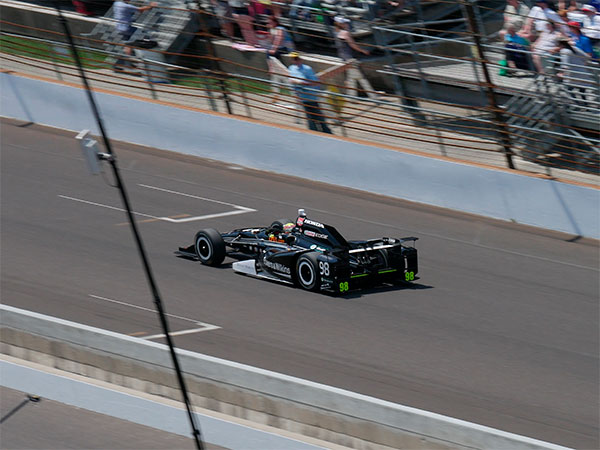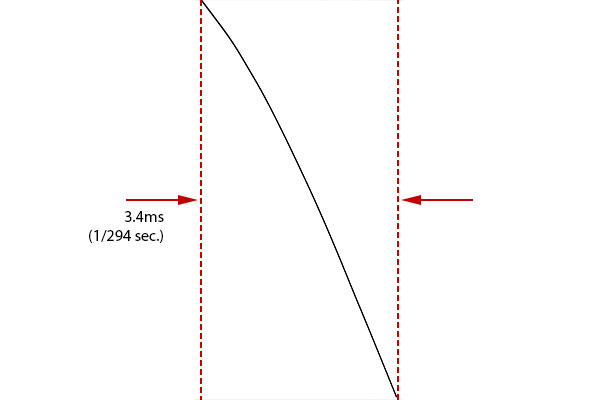A new test debuts at IR: The Sony A9’s rolling shutter really *is* pretty dang fast!
posted Tuesday, August 22, 2017 at 10:21 PM EDT

If you've ever shot a video that included a fast-moving subject like an aircraft's propellers, you'll have noticed that they seem to be being whipped through the air and then bizarrely discarded. If so, you've been a victim of the rolling shutter effect. (Or more colloquially, the "jello effect.") This unusual photographic oddity is best-known these days for its adverse effect when shooting videos, but it's equally an issue in still photography, too.
But what causes it, and how can we measure and quantify its potential impact on your photography before you lay down your hard-earned cash on a new camera purchase? These are just the kinds of questions we at IR love to roll up our sleeves and answer for you!

Rolling shutter can be a serious issue for much more than just in-flight photos and videos from your window seat. In still photography, the jello effect can cause things like racing cars that seem to lean forwards as if eagerly willing themselves towards the finishing line, helicopter rotors that appear to bow like bananas, and guitar strings that apparently ripple like tiny sine waves along their length. And in videos, it can rear its ugly head when you pan across your subject, with utility poles, street lamps and buildings in the background appearing to lean drunkenly to one side.
Whether for stills or video, rolling shutter is caused by the way your photos are captured, although its severity typically varies depending on whether you're using a mechanical or electronic shutter. (The latter is especially prone to rolling shutter, which is why it's become such a well-known phenomenon in videos.)

When you trip the shutter or record a frame of video, your camera doesn't capture the entire scene simultaneously. For still imaging with a mechanical shutter, the image sensor is exposed to your subject for just a brief (and very precisely-controlled) period while a slit in the mechanical shutter curtains pass in front of it. And for videos or still capture with an electronic shutter, the camera takes a similarly brief period to read out data from the image sensor, typically proceeding line by line down the image sensor as it clocks the data off into its buffer memory.
And in both cases, it's that brief time where the image is being formed that's the root cause of the problem. It would be great if our subjects could freeze in the perfect pose for us, but in the real world life keeps moving on even as our mechanical shutter or sensor readout process are in motion. When you start to capture the image, your subject is in one location in the image frame, but by the time that capture has finished, it may have moved to an entirely different position, causing it to skew drunkenly to one side. (Or for subjects with a repetitive motion such as a guitar string or propeller blades, potentially causing even more bizarre distortions like warped blades that don't even connect to the hub at the propeller's center.)

The severity of the effect depends upon a couple of key factors: How quickly your subject is moving, and how long that mechanical shutter motion or sensor readout process takes to complete. Obviously, the first point is going to vary depending upon your subject, but that second point is one we can quantify -- and as photo geeks who just love to get into the nitty gritty of measuring and analyzing every last detail of the cameras we review, we've been working behind the scenes for some time now to come up with a simple, repeatable test which would allow us to do just that.
And now we're there! Today, we're proud to bring you the first results from our new rolling shutter test, and for a camera whose still imaging capabilities will make this test a very enlightening one indeed!
How we test rolling shutter
So what's our new process for measuring rolling shutter precisely and repeatably? Well, that would be telling, and as we're sure you'll understand, we'd really rather not give away our trade secrets to competitors ;-)
There's nothing magic about the process, though, and (high-priced) commercial systems are available to perform these tests, using rows of rapidly-clocked LEDs. Our method doesn't involve clocking LEDs, but accomplishes the same end, possibly even more accurately.
Our test is very direct: We pass a vertical light source (think of a moving, vertical slit in front of a lighted background) across the frame from left to right, at a very high, precisely controlled speed, and then analyze the image that the camera produces.
If you've seen things like leaning light poles in rapidly-panned videos, that's essentially what we're doing. The key is in very precisely controlling the speed at which the light source moves across the frame. Our system does that to within a small fraction of a percent.
Despite the very precise control over the speed that the light source moves at, there's still a little interpretation to be done, particularly with mechanical shutters. The edges of the pattern with electronic shutters are pretty well-defined, but the patterns produced by mechanical shutters are a little fuzzy. After scratching our heads a little, we realized that this is because the focal-plane shutters in modern cameras are necessarily located a little bit in front of the sensor's focal plane, so the shadows they cast on the sensor surface are a bit soft-edged.
Despite the soft edges, we found that we could still measure the speed of the shutter curtains very precisely. The trick is to simply make sure that we pick the same point within the fuzzy edge for both the start and end of the sweep across the frame. We discovered that differences from one person to another don't have much impact on the final results, as long as each person is consistent in where they "call" the edge at top and bottom of the frame. Somewhat to our own surprise, we found that variations in our measurements of rolling shutter time from one shot to the next were extremely small, on the order of just +/- 0.5%. That's certainly more than enough to tell the differences between different cameras.
Sample variation?
As far as we know, no one is currently measuring and publishing rolling shutter performance. If/when someone does, we'll be interested to see how closely their results match ours. As with most of our tests, we typically have only a single sample of a camera to test, so we don't have any way of telling how much variation there might be between individual units.
With rolling shutter, though, sample to sample variation is probably very small. For electronic shutter implementations in particular, the speed will be controlled by the system's electronic "clock" signal, which is usually derived from a crystal oscillator, so variations of more than a percent or so are very unlikely. We could imagine greater variation in mechanical shutter systems, and even a 5% variation probably wouldn't affect exposure very much. (A 5% change is less than a tenth of an EV - actually 0.07 of a stop: https://www.logcalculator.net/)
Still, for a camera to be able to expose accurately, its mechanical shutter has to travel at a pretty precisely controlled rate (and the slit that's opened has to be likewise very precisely sized).
Bottom line, we don't expect there to be significant differences between the Sony A9 we measured in this particular test and others on the market.
Sony A9 rolling shutter test results
Let's look at our results for the Sony A9's mechanical shutter first. The A9 has an x-sync speed for flash exposures of 1/250 second. That means that at 1/250 second, there's at least one point at which the focal plane shutter is completely open, exposing all of the sensor's area at once. So we'd expect to find a rolling-shutter time for its mechanical shutter at least a little faster than 1/250 second, to allow at least margin of error for sample variation and the precise timing of the flash discharge.

When we measured the actual shutter-transit time for the A9, we did in fact find it to be a little faster than the 1/250 second x-sync speed. Averaging over a number of individual measurements, we clocked the transition from top to bottom of the frame right at 3.4 milliseconds, or 1/294 second. (We did check a number of frames to ensure that our individual measurements were in fact accurate, but all results happily turned out to be within +/- 0.5% of each other.)
When we first looked at the data, we were surprised to see the first-curtain speed vary across the frame, starting out slower and then speeding up as it traveled towards the bottom. Just a bit of thought led to a "duh!" moment, though: Of course a mechanical shutter takes some small but finite amount of time to accelerate to its full speed! (This left us even further in awe of shutter-mechanism mechanical designers, though: At speeds faster than x-sync, the width of the slits in focal-plane shutters must likewise vary as they move down the frame, else the top and bottom of the frame would be exposed differently!)

As expected, the A9's electronic shutter was slower; we measured the time it took to travel from the top to the bottom of the frame at 6.68 ms, or just under 1/150 second. That's only about half the speed of the mechanical shutter, but it's still quite respectable, and fast enough that most users will be unlikely to see any distortion in moving subjects or while panning.
Our previous (and as yet unpublished; stay tuned!) rolling shutter testing concentrated on video recording, where we found typical values ranging from 1/40 - 1/75 second. We hadn't previously paid a lot of attention to still-shooting electronic shutters, as they didn't strike us as having very strong use cases. With the A9, though, the e-shutter is the only way to get to it's astonishing 20fps full-resolution continuous-shooting frame rates, and Sony has been touting the advantages of truly silent (electronic-shutter) shooting for noise-sensitive situations and truly candid people-photography.
Given the strong use cases and seeming step forward in performance, we thought it made sense to take a look at the A9's rolling shutter performance, even though we don't yet have our camera database set up to handle the data for all the other cameras we've tested to date.
Bottom line, though, the Sony A9's rolling shutter timing for still photography is pretty impressive, and is fast enough that it shouldn't be an issue for most users looking to shoot at the camera's maximum 20 fps full-resolution frame rate.
Please let us know your thoughts and questions about this new test and the Sony A9's performance in it in the comments below, and stay tuned for more rolling shutter tests going forward!